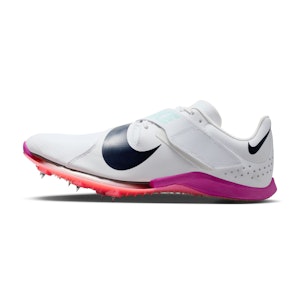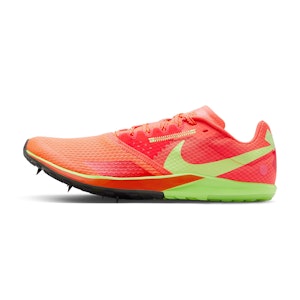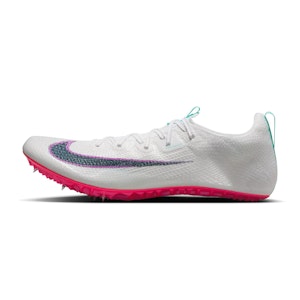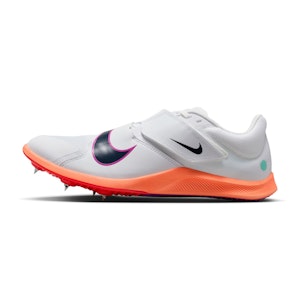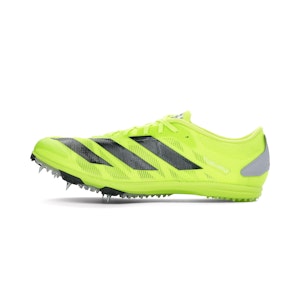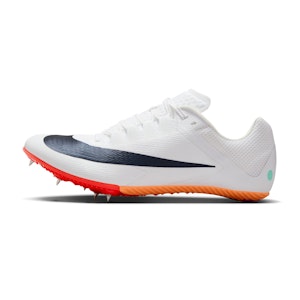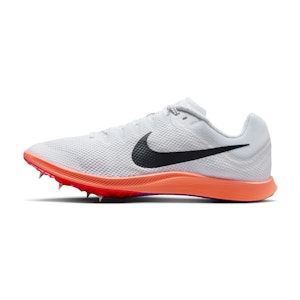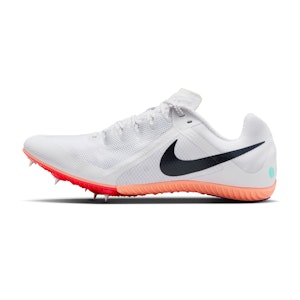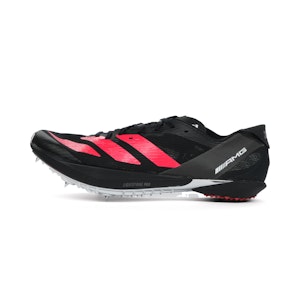Running spikes
Buying Athletics Spikes
Spikes are a must-have for every serious track athlete. Athletics spikes are used during competitions and training and provide more grip and a more powerful take-off when running, sprinting and jumping. Running spikes usually have metal pins that can be replaced when they become blunt or when you want to use a different pin length. The number of pins and the type of shoe often varies per event. You will find the newest and most popular track spikes and track shoes at 21RUN. We have spikes for women and spikes for men, but also a selection of kids running spikes.
Different Types of Spikes
There are many different types of spikes. Each athletic event actually has its own unique specialist shoes. There are also all-round spikes that are suitable for almost all athletics events and cross country spikes that are suitable for running cross country races.
Notable Brands and Models
Asics’ Hyper series, Nike’s Zoom Rival series and adidas’ Adizero and adidas’ Adistar series are well-known spikes series. All four series come in different models for different events.
- There are the Nike Zoom Rival D, the adidas Distancestar and the Asics Hyper LD for long distances;
- the Nike Zoom Rival S and the Asics Hypersprint for the sprinting events;
- the Nike Zoom Rival M and the Asics Hyper MD for middle distances, and the Nike Zoom Rival XC for cross country running.
- Additionally there are the Adizero LJ and Adizero HJ for long jump and high jump and the Adizero Javelin for javelin throw.
21RUN has a wide range of athletic spikes and running spikes of top brands such as Nike, ASICS and adidas as well as of New Balance and other brands.
All-round Spikes
All-round athletics spikes are suitable for almost all athletics events. They often resemble middle distance spikes. They are lightweight and have an outsole that provides light cushioning.
Sprint Spikes
Sprinting spikes are specially made for reaching top speeds. They are usually very recognizable by their streamlined appearance, thin heel and curved forefoot. They often feature a zipper closure on top that conceals the laces and helps to ensure even less air resistance. Sprint spikes have more pins than most other spikes. This helps to ensure grip even during the enormous force that is released when sprinting at full speed. Because sprinters almost only run on their forefoot, sprinting spikes have the thinnest possible heel and offer virtually no cushioning. The hard and stiff plate under the forefoot gives little flexibility to minimize the loss of energy. To get the most out of sprint spikes, they must have a tight fit. Make sure, however, that they are the right size and that they don’t fit too tight. At 21RUN you will find sprinting spikes for men as well as sprinting spikes for women.
Middle Distance Spikes
For track athletics, all distances between 800 meters and 1500 meters are considered middle distance events. All shorter distances are viewed as sprinting and all longer distances are considered long distance events. The middle distance spike is a shoe that has characteristics of both sprinting and long-distance spikes. It is a lightweight and fast shoe, but has a full sole which provides some cushioning. Hurdlers often use middle distance spikes because these spikes are fast enough for shorter distances, but also offer some cushioning during landing phase. These spikes are also viewed and used as all-round spikes.
Long Distance Spikes
In track athletics all distances above 3000 meters are considered long distances. Long-distance spikes have a more flexible and flatter sole and have fewer pins. To provide support and cushioning to the feet they have a full-length sole and are a bir thicker. Although they have a tight fit, long-distance spikes fit slightly wider than sprinting spikes.
Cross Country Spikes
Cross spikes look a lot like long-distance spikes. They usually only have 6 pins and the outsole offers a lot of traction and has grooves to drain away water. Because cross country circumstances are a bit tougher and therefore ask more of the outsole, the outsole is a bit more durable than those of track spikes. Because the surface is often not flat, these types of spikes also offer more support to the midfoot. When there is a lot of hard underground on a course, you can always replace the pins with blind pins. This way the thread remains protected and you will still experience enough traction.
High Jump Spikes
High jump spikes have a flat and thick sole. The outsole allows you to also add four pins underneath the heel and the midsole offers some cushioning to alleviate pressure. The pins in the heel ensure grip during the run-up bend and during take-off. The rigid outsole and the pins ensure a powerful take-off. High jump spikes often feature a strap on the bridge of the foot, which optimizes their fit and keeps the feet in place during jumping. The strap also helps to support the ankle. Some athletes use high jump spikes for javelin throw.
Javelin Throw
Spikes Javelin throw spikes look a lot like high jump spikes: they have pins in the heel, have a rigid and flat sole and often feature a strap over the bridge of the foot. There are, however, some important differences between these two types of spikes. There are, for instance, javelin spikes with a high shoes and javelin spikes with a low shoe. Javelin spikes also have a reinforced toe part and a heel block. The high shoe helps to protect the ankle, the reinforced toes prevent damage to the shoes when they are dragged over the track and the heel block protects the heel when the body is blocked and the javelin thrown. Some athletes use javelin spikes for high jump.
Long Jump Spikes
Long jump spikes in many ways resemble sprint spikes. Just like with sprinting events, they have to ensure a speedy run-up and a powerful take-off. Therefore, long jump spikes are often light of weight. The spikes provide excellent support and thanks to the strap over the bridge of the foot, they ensure that the feet stay in place. Long jump spikes often have a substantial spike plate underneath the forefoot. Some athletes also use long jump spikes for triple jump or pole vault.
Triple Jump Spikes and Pole Vault Spikes
Although some brands make specific triple jump and pole vault spikes, most brands make a spike that can be used for both events. These types of spikes have a rigid spike plate underneath the forefoot and a midsole which provides cushioning and protects the feet. Many triple jump and pole vault spikes have a strap over the foot which allows you to fit the shoes very tightly onto the feet. These shoes are reasonably light of weight. Some athletes also use these spikes for triple jump.
In addition to the spikes mentioned above, there are also specialist shoes for shot put, discus throw and hammer throw all have a shoe specially made for those events.
Spike Pins
In addition to the different types of shoes, there are also different spike pins. Spike pins can differ in length, shape and material. Most disciplines prefer a certain spike shape or size. There are spike pins in a number of lengths, varying from 5 mm to as much as 18 mm. However, the most common size is 6 mm. The maximum length is often 9 mm, except for high jump and javelin throw, where it is often allowed to use spikes with a length up to 12 mm.
Spike pins actually come in three different forms; pyramid shape, needle shape and Christmas tree shape.
- The pyramid spikes are conical pins that run from a thick base to a sharp point. The sharp point penetrates the track while running and offers grip.
- The Needle pins are sharp, narrow pins that have the same width from the base to the tip. This type of tip also penetrates the track to provide grip.
- The Christmas tree pins are layered spikes with no sharp point at the end.





















